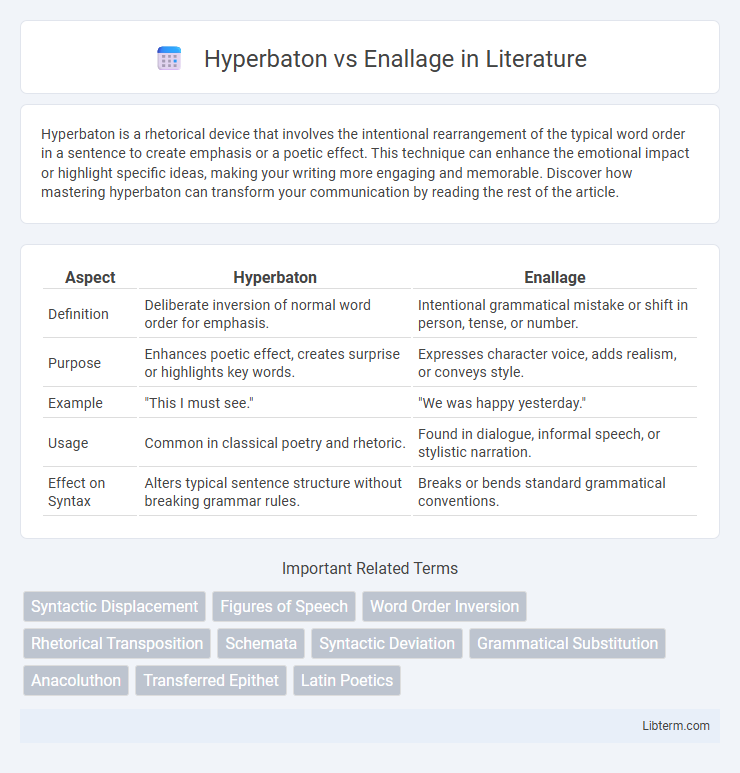Hyperbaton is a rhetorical device that involves the intentional rearrangement of the typical word order in a sentence to create emphasis or a poetic effect. This technique can enhance the emotional impact or highlight specific ideas, making your writing more engaging and memorable. Discover how mastering hyperbaton can transform your communication by reading the rest of the article.
Table of Comparison
| Aspect | Hyperbaton | Enallage |
|---|---|---|
| Definition | Deliberate inversion of normal word order for emphasis. | Intentional grammatical mistake or shift in person, tense, or number. |
| Purpose | Enhances poetic effect, creates surprise or highlights key words. | Expresses character voice, adds realism, or conveys style. |
| Example | "This I must see." | "We was happy yesterday." |
| Usage | Common in classical poetry and rhetoric. | Found in dialogue, informal speech, or stylistic narration. |
| Effect on Syntax | Alters typical sentence structure without breaking grammar rules. | Breaks or bends standard grammatical conventions. |
Introduction to Hyperbaton and Enallage
Hyperbaton is a rhetorical device characterized by the deliberate inversion of conventional word order to create emphasis or a dramatic effect, commonly seen in classical poetry and prose. Enallage involves the intentional substitution of one grammatical form for another, such as changing tense, person, or number, to achieve stylistic variation and enhance expression. Both figures of speech function as fundamental tools in literary and rhetorical analysis, enriching language by manipulating syntax and grammatical forms.
Defining Hyperbaton: Meaning and Usage
Hyperbaton is a rhetorical device involving the deliberate rearrangement of words to create emphasis or a poetic effect, often placing adjectives after nouns or separating words that normally appear together. It disrupts the conventional word order to highlight specific ideas or enhance the rhythm in literary and oratory contexts. Common examples include Shakespeare's works, where hyperbaton intensifies emotional expression and draws attention to particular phrases.
Understanding Enallage: Concept and Examples
Enallage is a rhetorical device that involves the intentional substitution of one grammatical form for another, enhancing expression and emphasis in language. Common examples include shifting verb tense or pronoun person to create stylistic effect, such as using "I is" instead of "I am" to convey characterization or dialect. Understanding enallage aids in recognizing nuanced language shifts that enrich literary and rhetorical impact, distinguishing it from hyperbaton, which rearranges word order without altering grammatical forms.
Historical Origins of Hyperbaton
Hyperbaton, a rhetorical device originating in ancient Greek literature, involves the deliberate inversion or separation of words for emphasis or poetic effect, distinguishing it from enallage, which is the substitution of one grammatical form for another. Historical origins of hyperbaton trace back to Classical Greek poets such as Homer and Pindar, who employed this technique to enhance meter and dramatic impact. The complexity of hyperbaton found in Latin literature, especially in the works of Cicero and Virgil, showcases its evolution and significance in classical rhetoric and poetry.
Historical Development of Enallage
Enallage, an ancient rhetorical device originating from classical Greek and Latin literature, involves the intentional substitution of one grammatical form for another to enhance expression and emphasis. Throughout history, classical rhetoricians like Aristotle and Quintilian analyzed and formalized enallage as a key stylistic technique contrasting with hyperbaton's syntactic rearrangement of word order. The historical development of enallage reflects its sustained use in adapting language structures for poetic innovation and persuasive speech across various literary periods.
Syntactic Differences: Hyperbaton vs Enallage
Hyperbaton involves the deliberate rearrangement of word order to create emphasis by separating related words, often placing adjectives far from the nouns they modify. Enallage, by contrast, centers on the substitution of one grammatical form for another, such as using incorrect verb tense or person to achieve a rhetorical effect. While hyperbaton manipulates syntax through displacement within sentence structure, enallage changes standard grammatical agreements without altering word positions.
Stylistic Effects in Literature
Hyperbaton creates striking stylistic effects in literature by disrupting conventional word order, enhancing emphasis, and generating surprise or dramatic tension. Enallage shifts grammatical forms, such as tense or voice, to convey character voice, emotional intensity, or create vivid imagery. Both devices enrich narrative texture, providing authors with nuanced tools for expressive, memorable writing.
Hyperbaton and Enallage in Modern Writing
Hyperbaton in modern writing often serves to create emphasis and rhythm by disrupting the conventional word order, enhancing the literary effect without compromising clarity. Enallage involves deliberate grammatical shifts, such as changes in tense or person, to convey immediacy or character voice, enriching narrative depth. Both devices remain valuable tools for writers seeking stylistic variety and nuanced expression in contemporary prose and poetry.
Famous Examples in Classical Literature
Hyperbaton, a rhetorical device involving the inversion of word order for emphasis, appears prominently in Virgil's *Aeneid*, where phrases like "magno cum murmure montis" ("with a great rumble of the mountain") disrupt the expected syntax to heighten dramatic effect. Enallage, the deliberate misuse of grammar such as shifting verb tenses or pronouns, is famously employed by Shakespeare in *Julius Caesar*, exemplified by Mark Antony's phrase "Friends, Romans, countrymen, lend me your ears," where the plural form "friends" serves to engage a broad audience with pointed rhetorical impact. Both figures of speech enrich classical literature by manipulating linguistic norms to convey emotion, authority, and intensity.
Choosing Between Hyperbaton and Enallage
Choosing between hyperbaton and enallage depends on the desired stylistic impact and linguistic emphasis. Hyperbaton rearranges conventional word order to create emphasis or a poetic effect, while enallage involves the deliberate substitution of one grammatical form for another to add character or voice variation. Writers select hyperbaton to highlight specific elements within a sentence and use enallage to convey informal tone or express regional dialects effectively.
Hyperbaton Infographic

 libterm.com
libterm.com